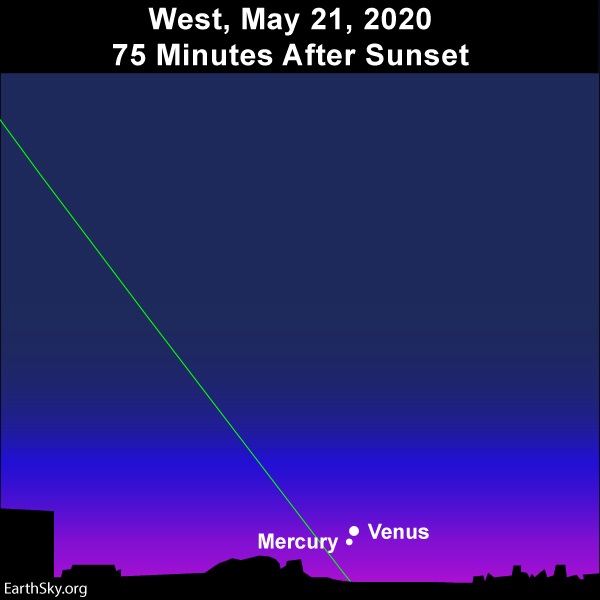Given clear skies and an unobstructed western horizon, the dazzling planet Venus – and the planet Mercury, our sun’s innermost planet – will be yours to behold after sunset from about mid-May 2020 until nearly the end of this month. It’ll be the year’s best evening apparition of Mercury for the Northern Hemisphere; but it’ll be a fairly decent apparition for the Southern Hemisphere, too. To find Mercury in mid-May, first look west after sunset for Venus. You can’t miss it. It’s very, very bright in the west after sunset. Next, draw a line with your mind’s eye between Venus and the sunset point. Mercury will be along that line, below Venus, near the sunset point.
Then watch in the coming evenings, as Mercury ascends in the evening sky, while Venus descends toward its June 3 passage between the Earth and sun. The conjunction of Venus and Mercury will come around May 20 and 21.

Venus ranks as the third-brightest celestial object to light up the heavens, after the sun and moon. You might see this brilliant beauty of a planet as little as 15 minutes (or less) after sunset. In mid-May – as Mercury is just beginning its ascent into our evening sky – bring binoculars, if you have them, to locate Mercury all the sooner after sunset in the bright twilight. With binoculars, you might spot Mercury near the sunset point on the horizon some 30 to 45 minutes after sunset.
Although Mercury is nowhere as bright as Venus, Mercury shines more brilliantly than a 1st-magnitude star. The difficulty will be that Mercury is in a sky bathed in twilight; the brightness of twilight will cause Mercury to look fainter than it really is.
Venus and Mercury will stay out longer after sunset at Earth’s more northerly latitudes. They’ll set sooner after the sun at Earth’s more southerly latitudes. We give the approximate setting times for Mercury and Venus at 60 degrees north latitude, 40 degrees north latitude, equator (0 degrees latitude) and 35 degrees south latitude for the few days around mid-May 2020 (assuming a level horizon):
60 degrees north latitude:
Mercury sets 1 1/2 hours after sunset
Venus sets 4 hours after sunset40 degrees north latitude
Mercury sets 1 1/6 hours after sunset
Venus sets 2 1/3 hours after sunsetEquator (0 degrees latitude)
Mercury sets less than one hour after sunset
Venus sets less than 2 hours after sunset35 degrees south latitude
Mercury sets over 1/2 hour after sunset
Venus sets 1 1/3 hours after sunsetWant more specific information? Click here for a recommended sky almanac.
But, as always with sky objects, things will change!
Conjunction of Venus and Mercury around May 20 and 21. Day by day, during the latter half of May 2020, watch for Mercury to set later and for Venus to set sooner after sunset. It’s inevitable that these two worlds will meet up for a conjunction, as Venus sinks into the sunset while Mercury ascends in the western sky. Depending on where you live worldwide, Mercury and Venus will be the closest together on the sky’s dome on May 21 or 22, 2020. These two worlds will be quite close together for several days before – and after – their conjunction. So – for some evenings around May 21 or 22 – take advantage of your opportunity to view both Mercury and Venus in the same binocular (or low-powered telescopic) field of view.

Even in mid-May, however – as Mercury is just beginning its ascent into the western evening sky – you can use Venus (and binoculars) to hop down to Mercury. Seek for Mercury beneath Venus and close to the sunset point on the horizon as evening dusk is giving way to darkness. Mercury is especially bright in mid-May 2020, shining some seven times brighter than a 1st-magnitude star (such as Spica). Mercury is dimming somewhat day by day, and will be shining about 3 times brighter than Spica by the end of the month.
Bottom line: Use dazzling Venus to locate Mercury at dusk in May 2020! It’s the best opportunity of 2020 to spot Mercury in the evening sky. If you live in the Northern Hemisphere, these next few weeks will provide your best view of Mercury’s evening apparition.











